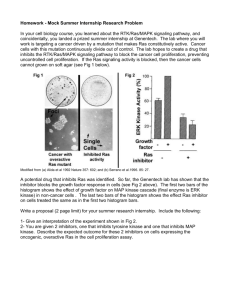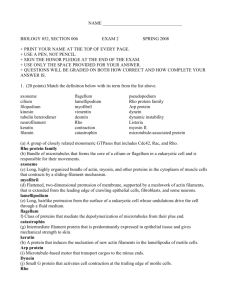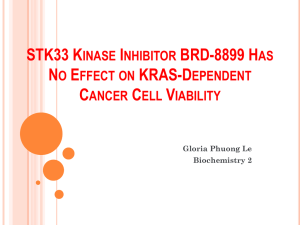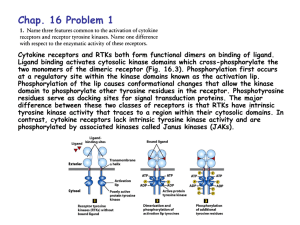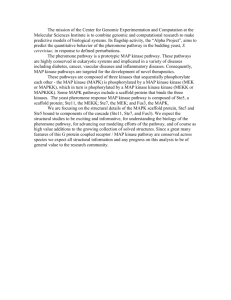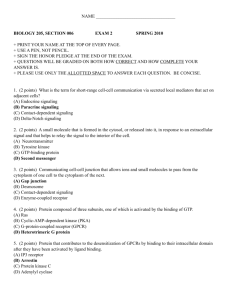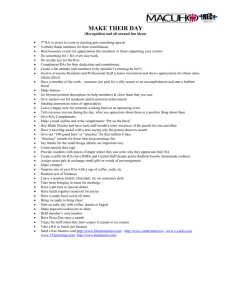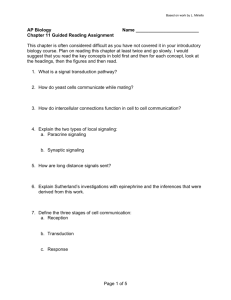Specialized signaling pathways: RTK associated pathways
advertisement
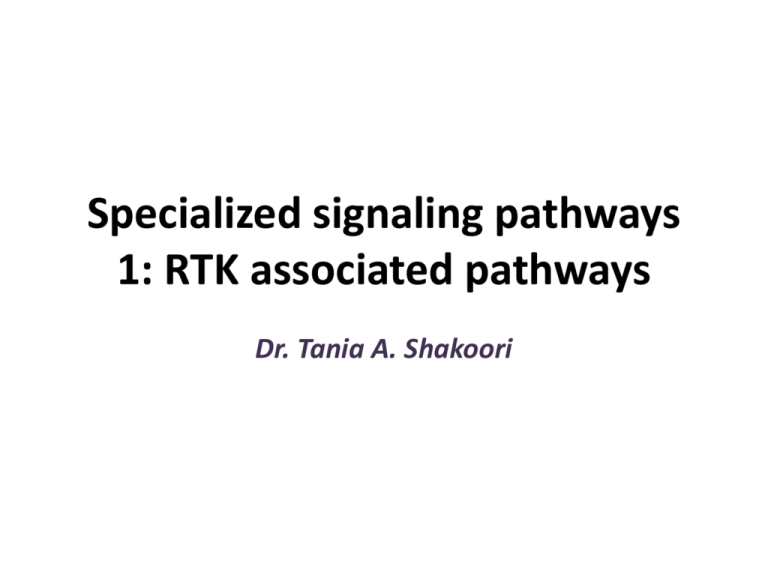
Specialized signaling pathways 1: RTK associated pathways Dr. Tania A. Shakoori Your Case • 50 year old woman works in a pesticide factory. Presents with bleeding in urine. After investigations you discover she has renal cell carcinoma • You decide to include a new drug in her treatment called Sorafenib- which is receptor tyrosine kinase inhibitor So what is this pathway? KEY CONCEPTS Receptor Tyrosine Kinases and Activation of Ras ■ RTKs which bind to peptide and protein hormones, may exist as preformed dimers or dimerize during binding to ligands. ■ Ligand binding leads to activation of the intrinsic protein tyrosine kinase activity of the receptor and phosphorylation of tyrosine residues in its cytosolic domain . The activated receptor also can phosphorylate other protein substrates. ■ Ras is an intracellular GTPase switch protein that acts downstream from most RTKs. Like G, Ras cycles between an inactive GDP-bound form and an active GTP-bound form. Ras cycling requires the assistance of two proteins, a guanine nucleotide–exchange factor (GEF) and a GTPase-activating protein (GAP). ■ RTKs are linked indirectly to Ras via two proteins: GRB2, an adapter protein, and Sos, which has GEF activity. KEY CONCEPTS Receptor Tyrosine Kinases and Activation of Ras ■ GRB2 binds to a phosphotyrosine in activated RTKs and also Sos, thereby bringing Sos close to membrane-bound RasGDP and activating its nucleotide exchange activity. ■ Binding of Sos to inactive Ras causes a large conformational change that permits release of GDP and binding of GTP, forming active Ras. GAP, which accelerates GTP hydrolysis, is localized near Ras GTP by binding to activated RTKs. ■ Normally, Ras activation and the subsequent cellular response require ligand binding to an RTK or a cytokine receptor. In cells that contain a constitutively active Ras, the cellular response occurs in the absence of ligand binding. MAP kinase pathway • In mammalian cells all receptor tyrosine kinases (RTKs), as well as most cytokine receptors, appear to utilize a highly conserved signal-transduction pathway in which the signal induced by ligand binding is carried via GRB2 and Sos to Ras, leading to its activation Induction of gene transcription by activated MAP kinase • (Especisally transcription factor cFos & c-Juninduces expression of many genes encoding proteins necessary for cells to progress through the cell cycle. ) KEY CONCEPTS: MAP Kinase Pathways • ■ Activated Ras triggers a kinase cascade in which Raf, MEK, and MAP kinase are sequentially phosphorylated and thus activated. Activated MAP kinase translocates to the nucleus • ■ Phosphorylation activates MAP kinases and many other protein kinases involved in signaltransduction pathways. • ■ Activation of MAP kinase following stimulation of a growth factor receptor leads to phosphorylation and activation of transcription factors which promote transcription of various early-response genes. • In mitogen activated pathway the activation of Ras is countered by: a) b) c) d) Protein Kinase C GTPase activating protein Phophotidyl inositol Inositol triphosphate Summary • Video: just copy and paste this link to get to the video • https://drive.google.com/file/d/0B8lwCh5HN 0GTckFodWhaZWVaQnc/view?usp=sharing Akt Pathway Recruitment and activation of protein kinase B (PKB) in PI-3 kinase pathways. In unstimulated cells, PKB is in the cytosol with its PH domain bound to the catalytic domain, inhibiting its activity. Hormone stimulation leads to activation of PI-3 kinase and subsequent formation of phosphatidylinositol (PI) 3-phosphates (see Figure 14-26). The 3-phosphate groups serve as docking sites on the plasma membrane for the PH domain of PKB and another kinase, PDK1. Full activation of PKB requires phosphorylation both in the activation lip and at the C-terminus by PDK1. Phosphoinositides as Signal Transducers • ■ Activated protein kinase B (Akt) promotes survival of many cells by directly inactivating several proapoptotic proteins and down-regulating expression of others. • ■ Signaling via the PI-3 kinase pathway is terminated by the PTEN phosphatase. Loss of PTEN, a common occurrence in human tumors, promotes cell survival and proliferation. Protein synthesis function of Akt • Akt Rheb mtor S6K (translation factor) binds to large subunit of ribosome translation Lowers concentration of FOXO • FOXO is a tumor suppressor protein (inhibits proliferation of cells) • Akt activated phosphorylates FOXO which is a substrate for enzyme ubiquitin ligase ubiquitinilated FOXO formed destroyed by a complex of proteases called proteosome • So what will be the effect of AKT signalling? • Excessive signaling • Decreased signaling? Insulin and Akt • The principal mechanism by which insulin causes a reduction of the blood glucose level is by increasing import of glucose by fat and muscle cells. This effect is mediated by protein kinase B, which through mechanisms that are not fully understood causes movement of the GLUT4 glucose transporter from intracellular membranes to the cell surface. The resulting increased influx of glucose into these cells lowers blood glucose levels. Summary • Just copy paste the following to get to the video: • https://drive.google.com/file/d/0B8lwCh5HN 0GTem1TV0lyOHNlSjQ/view?usp=sharing Question Which signaling pathway mediates the following cellular responses: stimulation of GLUT 4 translocation to the plasma membrane, inhibition of glycogen synthase kinase 3 (GSK3) and induction of triglyceride synthesis? A Ras/mitogen activated protein (MAP) kinase B PI-3 kinase – Akt/protein kinase B (Akt/PKB) C AMP kinase (AMPK) D Mammalian target of rapamycin (mTOR)
